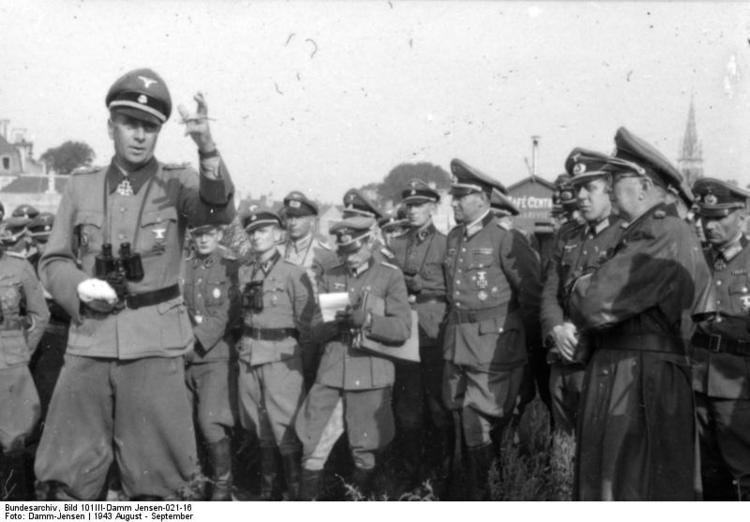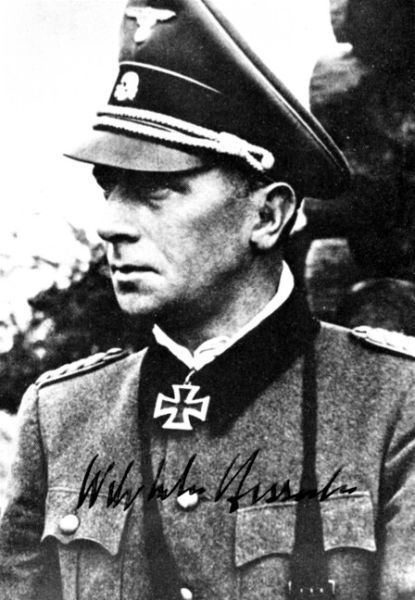Nickname(s) Willi Years of service 1914–45 | Name Wilhelm Bittrich | |
 | ||
Born 26 February 1894Wernigerode, Province of Saxony, Kingdom of Prussia, German Empire ( 1894-02-26 ) Service/branch Luftstreitkrafte Waffen SS Service number NSDAP #829,700SS #39,177 Similar People | ||
General wilhelm bittrich
Wilhelm Bittrich (26 February 1894 – 19 April 1979) was a high-ranking Waffen-SS commander of Nazi Germany. Between August 1942 and February 1943, Bittrich commanded the SS Cavalry Division Florian Geyer, in rear security operations (Bandenbekämpfung, literally: "bandit fighting") in the Soviet Union.
Contents
- General wilhelm bittrich
- Vanguard Market Garden Wilhelm Bittrich
- World War I and inter war career
- World War II
- Conviction for war crimes
- Activities within HIAG
- Summary of SS career
- References

After his arrest in May 1945, Bittrich was extradited to France on charges of having ordered the execution of 17 members of the French Resistance. He was tried, convicted and sentenced to five years in prison. Following his release from prison, Bittrich became active in HIAG, a revisionist organization and a lobby group of former Waffen-SS members and served as chairman during the 1970s.

Vanguard Market Garden - Wilhelm Bittrich
World War I and inter-war career

Born in 1894 into a family of a traveling salesman, Bittrich volunteered for military service after the outbreak of World War I. He served on the Western and Italian Front and was awarded both classes of the Iron Cross. In 1916, Bittrich transferred to the Luftstreitkräfte and trained as a pilot. He served with several units, including the 37th Fighter Squadron.

From March to July 1919, Bittrich was a member in the paramilitary Freikorps under the General Bernhard von Hülsen during the German Revolution of 1918–19. In 1923, Bittrich was accepted into the Reichswehr of the Weimar Republic. In December 1931 or early 1932, Bittrich joined the Nazi Party (NSDAP) (Nr. 829,700). From March until June 1932, he served in the Sturmabteilung (SA). On 1 July 1932, Bittrich joined the SS (Nr. 39,177) and served in various SS units in leadership positions, reaching the rank of Hauptsturmführer by June 1934.
From August 1934, Bittrich was a commander of the Politische Bereitschaft (Political Readiness Detachment) in Hamburg. This unit later became part of the SS-Standarte "Germania" in the SS-Verfügungstruppe (SS-VT). By January 1938, Bittrich was promoted to Obersturmbannführer. He was given command of a battalion in the SS-Regiment "Deutschland". With this unit he participated in the annexation of Austria into Nazi Germany in March 1938. In May 1939, Bittrich was posted to the headquarters unit of the Leibstandarte SS Adolf Hitler (LSSAH) and was promoted to Standartenführer in June 1939.
World War II
He took part in the invasion of Poland (1939), assigned as LSSAH Chief of Staff to Sepp Dietrich. In January 1940 through October 1941, he was commander of the Regiment "Deutschland" and fought in the battle of France. From the summer of 1942 through February 1943, Bittrich commanded SS Cavalry Division Florian Geyer, that was tasked with rear-security operations (Bandenbekämpfung, literally "bandit-fighting") in the Soviet Union. On 9 July 1942 Bittrich attended a conference called to convey the principles of the Bandenbekämpfung to senior police and security leaders. Organized by Heinrich Himmler, the conference included Kurt Daluege, Erich von dem Bach-Zelewski, Odilo Globocnik, Bruno Streckenbach and others. The policies included collective punishment against villages suspected of supporting partisans, automatic death penalty for immediate families of suspected partisans, deportation (to labor and death camps) of women and children, and confiscation of property for the state.
He assumed temporary command of the 2nd SS Panzer Division Das Reich from 14 October 1941 through 12 December 1941, after Paul Hausser had been wounded. He then was given command over the 9th SS Panzer Division Hohenstaufen effective February 1943 until 1 July 1944. On 1 July 1944, he was appointed commander of the 2nd SS Panzer Corps. The 2nd Panzer Corps fought in Normandy, at Arnhem and later in Hungary. Bittrich was listed as a recipient of the Knight's Cross of the Iron Cross with Oak Leaves and Swords by the Association of Knight's Cross Holders, although no record of the award could be found in the German archives due to the irregular nature of its presentation.
Conviction for war crimes
After his arrest on 8 May 1945 he was extradited to France on charges of having ordered the execution of 17 members of the Resistance in Nîmes. The trial revealed that Bittrich had not given such an order and had even opened procedures against the responsible officers. As the commander in charge of the troops who committed the execution, he was held responsible for their misconduct and sentenced to five years in prison. The sentence was considered as served after a long pretrial detention. He was put on trial for a second time in 1953 and sentenced to five years in prison for countenancing hangings, pillage and arson, but was acquitted by the French court in Bordeaux again and released in 1954. He was never brought to trial for any actions and war crimes of the 8th SS Cavalry Division Florian Geyer in the Soviet Union.
Activities within HIAG
Following his release from prison, Bittrich became active in HIAG, a revisionist organization of former Waffen-SS members. In the 1970s, he served as the organization's chairman. Bittrich died in Wolfratshausen, Bavaria on 19 April 1979.
